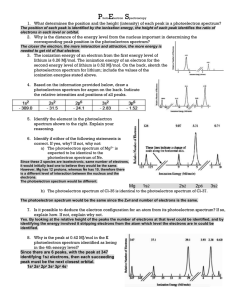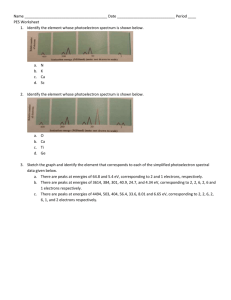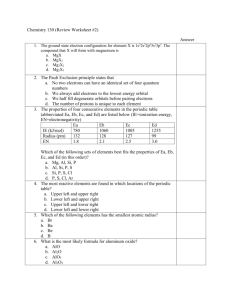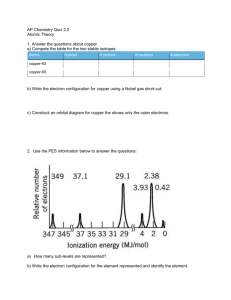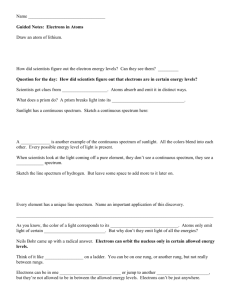Photoelectron Spectroscopy Worksheet: AP Chem HW
advertisement
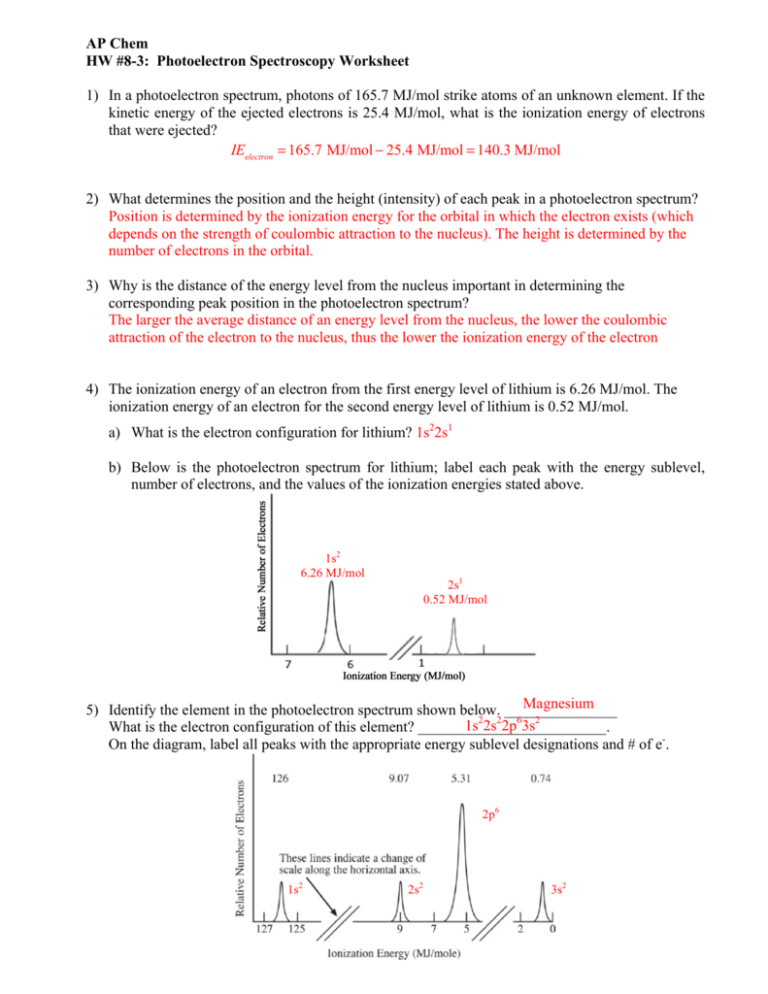
AP Chem HW #8-3: Photoelectron Spectroscopy Worksheet 1) In a photoelectron spectrum, photons of 165.7 MJ/mol strike atoms of an unknown element. If the kinetic energy of the ejected electrons is 25.4 MJ/mol, what is the ionization energy of electrons that were ejected? IEelectron = 165.7 MJ/mol − 25.4 MJ/mol = 140.3 MJ/mol 2) What determines the position and the height (intensity) of each peak in a photoelectron spectrum? Position is determined by the ionization energy for the orbital in which the electron exists (which depends on the strength of coulombic attraction to the nucleus). The height is determined by the number of electrons in the orbital. 3) Why is the distance of the energy level from the nucleus important in determining the corresponding peak position in the photoelectron spectrum? The larger the average distance of an energy level from the nucleus, the lower the coulombic attraction of the electron to the nucleus, thus the lower the ionization energy of the electron 4) The ionization energy of an electron from the first energy level of lithium is 6.26 MJ/mol. The ionization energy of an electron for the second energy level of lithium is 0.52 MJ/mol. a) What is the electron configuration for lithium? 1s22s1 b) Below is the photoelectron spectrum for lithium; label each peak with the energy sublevel, number of electrons, and the values of the ionization energies stated above. 1s2 6.26 MJ/mol 2s1 0.52 MJ/mol Magnesium 5) Identify the element in the photoelectron spectrum shown below. _______________ 2 2 6 2 1s 2s 2p 3s What is the electron configuration of this element? _________________________. On the diagram, label all peaks with the appropriate energy sublevel designations and # of e-. 2p6 1s2 2s2 3s2 6) Based on the ionization energies provided below, draw a photoelectron spectrum for argon. Indicate the relative intensities and positions of all peaks. 1s2 2s2 2p6 3s2 3p6 309.0 31.5 24.1 2.83 1.52 RI = 6 24.1 MJ RI = 2– 309.0 MJ RI = 2– 31.5 MJ RI =6 1.52 MJ RI = 2 2.83 MJ 7) Look at the previous three questions (#4, #5 and #6). The first peak (the peak all the way at the left) for each of the elements in those questions all correspond to the ionization energy for the 1s electrons. Why do the values for these ionization energies increase when one goes from lithium (6.26 MJ), to the element in question #5 (127 MJ) and then to Argon (309 MJ)? As the number of protons in the nucleus, hence nuclear charge Z, increases from 3 in Li to 12 in Mg (Question 5) to 18 in Ar, the electrons in the 1s orbital are more strongly attracted by the coulombic attraction to the nucleus, so require greater amounts of energy to ionize. 8) Identify if either of the following statements is correct. If correct, explain why. If not correct, explain why not: 2+ a) The photoelectron spectrum of Mg is expected to be identical to the photoelectron spectrum of Ne. False. Although isoelectronic with Ne, Mg2+ has two more protons, so the electrons are attracted more strongly to the nucleus and will have correspondingly higher ionization energies. 35 37 b) The photoelectron spectrum of Cl is identical to the photoelectron spectrum of Cl. True. The only difference between the isotopes is the number of neutrons, which are neutral and thus have no effect on the coulombic attraction of the electrons to the nucleus 9) Examine the graph at the right. a) Which electron(s) is represented by the 0.77 3d1 peak?________________ b) Which electron(s) is represented by the 0.63 peak? 4s2 _______________ c) Scandium loses two electrons when forming Sc2+. Which electrons are most likely to be 4s2 removed? ____________ Explain the logic for your answer. The electron configuration os Sc is [Ar]4s23d1. The single electron is the 0.77 MJ peak, and the 4s electrons are the 0.63 MJ peak. Since it has a lower IE, the 4s electrons will be easier to remove.
